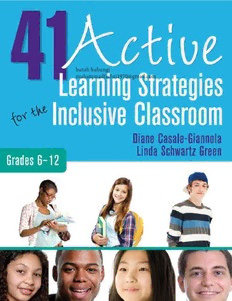Table Of Contentbutuh hubungi
[email protected]
41 Active
Learning Strategies
for the
Inclusive Classroom
Grades 6–12
This book is dedicated to the memory of my parents, Phyllis and Abby
Schwartz, who would have gotten the biggest kick out of seeing this book in
print; you are missed.
Linda Schwartz Green
This book is dedicated to my sisters, Ann Marie and Donna, for their
unwavering support and love no matter what time, what place, or how busy. I
couldn’t have done it without you…. I will always be grateful!
Diane Casale-Giannola
41 Active
Learning Strategies
for the
Inclusive Classroom
Grades 6–12
Diane Casale-Giannola
Linda Schwartz Green
FOR INFORMATION:
Corwin
A SAGE Company
2455 Teller Road
Thousand Oaks, California 91320
www.corwin.com
SAGE Publications Ltd.
1 Oliver’s Yard
55 City Road
London, EC1Y 1SP
United Kingdom
SAGE Publications India Pvt. Ltd.
B 1/I 1 Mohan Cooperative Industrial Area
Mathura Road, New Delhi 110 044
India
SAGE Publications Asia-Pacific Pte. Ltd.
3 Church Street
#10-04 Samsung Hub
Singapore 049483
Copyright © 2012 by Corwin
All rights reserved. When forms and sample documents are included, their use is
authorized only by educators, local school sites, and/or noncommercial or nonprofit entities
that have purchased the book. Except for that usage, no part of this book may be
reproduced or utilized in any form or by any means, electronic or mechanical, including
photocopying, recording, or by any information storage and retrieval system, without
permission in writing from the publisher.
All trade names and trademarks recited, referenced, or reflected herein are the property of
their respective owners who retain all rights thereto.
Printed in the United States of America.
Library of Congress Cataloging-in-Publication Data
Casale-Giannola, Diane.
41 active learning strategies for the inclusive classroom, grades 6-12/Diane Casale-
Giannola, Linda Schwartz Green.
p. cm.
Includes bibliographical references and index.
ISBN 978-1-4129-9397-5 (pbk.)
1. Active learning. 2. Education, Secondary. 3. Inclusive education. I. Green, Linda
Schwartz. II. Title. III. Title: Forty-one active learning strategies for the inclusive
classroom, grades 6-12.
LB1027.23.C22 2012
371.9’046—dc23
2012011685
This book is printed on acid-free paper.
12 13 14 15 16 10 9 8 7 6 5 4 3 2 1
Acquisitions Editor: Jessica Allan
Associate Editor: Allison Scott
Editorial Assistant: Lisa Whitney
Permissions Editor: Karen Ehrmann
Project Editor: Veronica Stapleton
Copy Editor: Pam Schroeder
Typesetter: Hurix Systems
Proofreader: Scott Oney
Cover Designer: Michael Dubowe
Contents
Preface
Acknowledgments
About the Authors
Chapter 1: Inclusion at the Secondary Level
Definition and Research
The Inclusive Classroom at the Secondary Level: Who Are We Teaching?
The Adolescent Learner
Helping Teachers Meet the Inclusion Challenge
What Is Active Learning?
Brain-Based Learning and the Adolescent Learner
Information Processing
Connections to Differentiated Instruction
Supporting State Standards and Assessments
Motivating Learners With Active Learning Strategies
Access Is Not Enough: The Critical Need to Address Diverse Student
Populations
The Beginning
Summary
Chapter 2: Active Learning Strategies in the Middle School and High
School: Debunking the Myth
Frequently Asked Questions
Reflect on the Experience
During the Lesson
After the Lesson
Final Thoughts
Chapter 3: Selecting and Implementing Active Learning Strategies for
the Inclusive Classroom
Classifications and Characteristics
Other Diverse Populations
Assessing Students and Indentifying Learning Characteristics
Using Strategies: Before, During, and After
How to Choose a Strategy to Meet Individual Student Needs
Learner Characteristics Described
How to Choose a Strategy to Meet Individual Teacher Needs
Learning Communities
And Now, the Next Step of Our Journey
Summary
Chapter 4: Grouping for Instruction: Who Goes Where With Whom to
Do What
How Do I Manage Everyone?
Whole Group Instruction
Small Group Instruction
Different Ways to Form Groups
And Now (Drum Roll, Please)… The Strategies
Summary
Chapter 5: Active Learning Strategies
1. ARTIFACT REVEAL (Students create artifacts related to learning
concepts)
2. BALL TOSS (The game of catch facilitates Q&A)
3. BAROMETER (Students take stands on controversial issues by voting
with their feet)
4. BOARD QUIZ (The whole class works collaboratively on quiz questions)
5. BODY LANGUAGE (Movement-based instruction involves using the body
to represent the content students are learning about)
6. BUILDING AN EXPERIENCE (The teacher creates an occurrence so that
students can experience the content in order to better facilitate
understanding)
7. BULLETIN BLOG (The class uses a bulletin board to blog information,
comments, and perspectives)
8. CONCEPT CLARIFICATION (The class works as a whole to describe and
discuss abstract concepts within a teacher-directed structure)
9. EXIT CARDS (End-of-lesson questions or comments identify student
progress or process)
10. FACE PLACE (Students create and share “Facebook” pages related to
learning topics and determine who they would “friend” among their peers)
11. FRAMEWORK (This simple yet effective strategy involves using an
outline or graphic organizer to help keep students focused on key content
throughout a lesson)
12. INFORMATION RINGS (Construct connected flashcards of data)
13. INVENTION CONVENTION (With the unit of study providing the
context, students design inventions to meet a perceived need)
14. JIGSAW (This cooperative learning experience helps students share
information in and among groups)
15. LINKED-IN (Students share and defend like opinions about a topic with
a visual)
16. LISTENING TEAMS (Each group is given one question or issue to report
on after a lecture or other direct instruction)
17. NEXT (Students take turns reconstructing information from
assignments)
18. PHILOSOPHICAL CHAIRS (Students sit in lines opposite one another
sharing perspectives from their topic or points of view)
19. PHOTO FINISH (Students use deductive reasoning to determine the
circumstances that led up to a conclusion that is presented in a visual
representation)
20. PLAYLIST (Students work in groups to create a playlist that reflects the
key themes of the content to be covered)
21. PUZZLE PIECES (Students walk around the room with Q&A cards to
find matches)
22. READING DISCUSSION CARDS (This strategy provides the opportunity
for students to discuss what they read informally but with an existing
structure)
23. RESEARCH SCAVENGERS (Students research information using a
variety of resources)
24. ROUND ROBIN (Students participate in group rotations responding to a
topic or question)
25. SELF-REPORTING (Students self-check progress and create action

